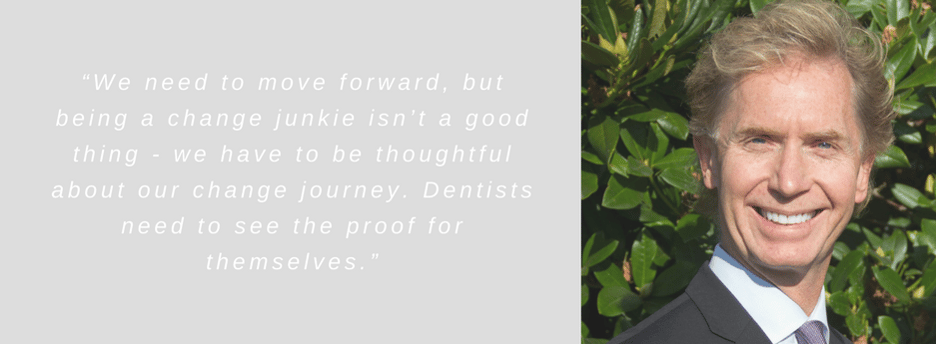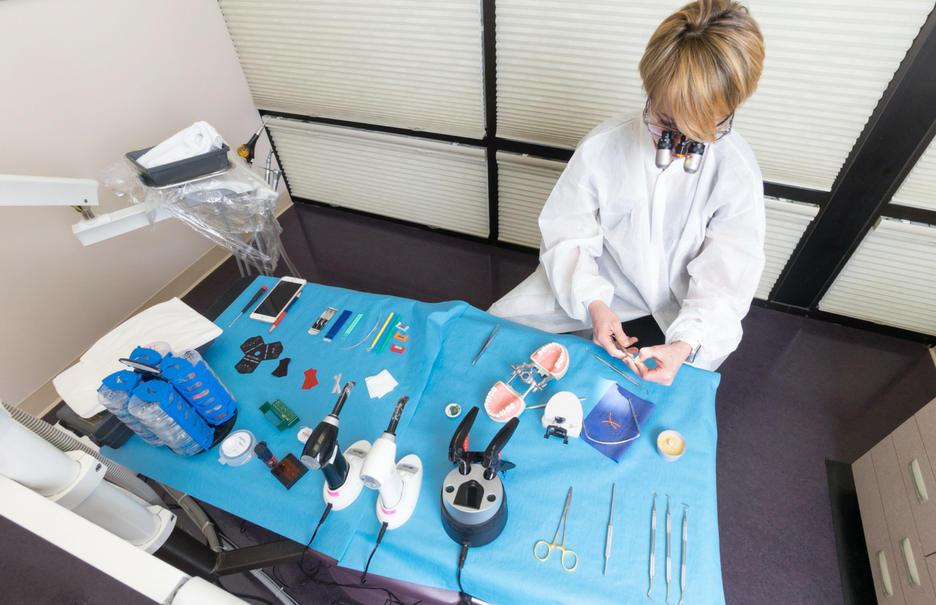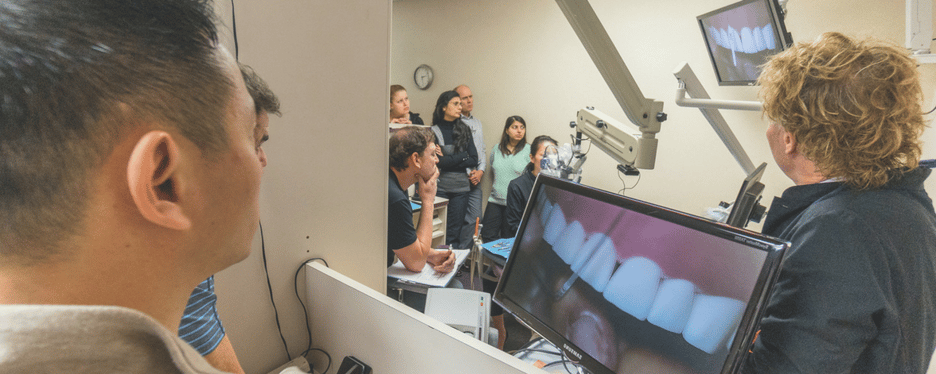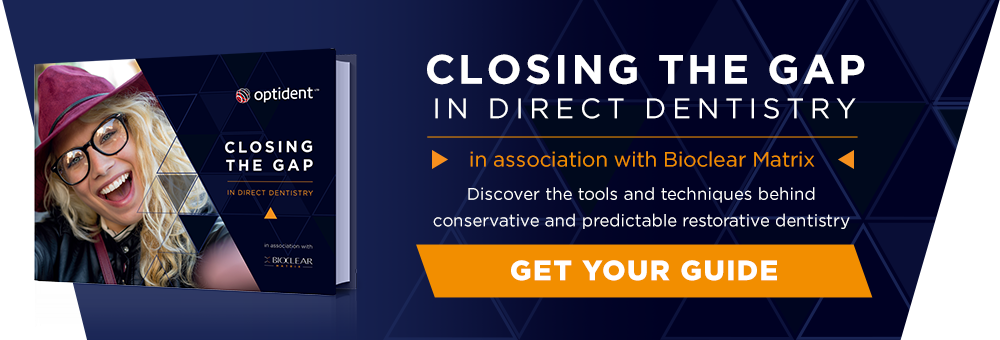Dentist and inventor, Dr David Clark has worked in dentistry for over 30 years, founding Bioclear Matrix Systems in 2009 with the aim of transforming restorative dentistry. The Bioclear Matrix offers progressive products and techniques evolving from traditional preparations, as well as dental matrix systems for anterior and posterior composite restorations.
Dr Clark’s mission is to provide dentists with the tools and equipment to allow for longer lasting, stronger and aesthetically superior composites. We ask him what inspired Bioclear and how it is making a difference to both dentists and their patients…

Q: In the 30 years you have worked in the industry, how have you seen dentistry change?
Patients have very high expectations of treatments today. They really want to be involved. They research online, evaluate what their dentist does, and they ask for alternatives or seek opinions from others.
In the old days I was the boss - I would say, ‘you need gold’ or ‘you need amalgam’, for example, and they agreed and wrote a cheque. Now they have questions, and they want options and explanations.
I think this shift is a good thing because it is driving me and other dentists towards more conservative treatments. Patients are looking for solutions that are less aggressive yet still aesthetic, and which last for 20 or 30 years. Dentists today can’t bond teeth, have it last for just two or three years and expect the patient to be happy - those days are over.
Q: What was the pivotal moment that inspired you to create Bioclear Matrix Systems?
I was running my own family dental practice in the state of Washington, US, when I got the chance to use an operating microscope on my patients. At the time, there were only about 10 dentists in the US who had microscopes in dentistry, and I thought they were great so I bought two.
They enabled me to start seeing things I had never seen before - things that were both puzzling and wonderful. But I also saw a lot of problems that no-one else saw, especially with composites. I decided we had to do better.
It is amazing that we have billion dollar companies building space age stuff, but when it comes to the important business of restoring a tooth in a conservative way, we use tools that are 50 years old.
Using high magnification, I felt like all of my amalgams, gold and porcelain got better, yet my composites didn’t improve. I would look at composites under the microscope and no matter whether I did them by hand, or layered them, or did them a little at a time, after a few years they just looked poor.
I knew there had to be something wrong with the system, that the method must be flawed.
Q: How long did it take to start realising your vision?
I wrote the first patent in about 2007, for diastema closure, or black triangles. Two years later I started Bioclear Matrix Systems as a company.
Once I invented the Bioclear Matrix, it challenged me to think of composites in a different way…
A year or two after founding Bioclear Matrix, we started to invent the Bioclear Method. This is an alternative to traditional direct composite restorations, instead introducing the use of ‘injection moulding’ composite placement techniques.
Many talented clinicians supported the innovation and contributed to it, especially my partner and co-director of Bioclear Learning Centres, Dr. Jihyon Kim.

When we looked under the microscope using 24 power magnification, we noticed the composite looked different when carried out using the Bioclear Method. Injection moulded restoration work looks like porcelain and lasts like porcelain, and feels just as smooth. And best of all, it’s healthier.
The Bioclear Method took at least five years to develop. It has been a long journey.
Q: How does Bioclear Matrix meet patients’ changing demands?
Historically there were two options for restoration - bonding, which doesn’t work that well for most of us, and porcelain, which looks great but has a high physiological and financial cost. The Bioclear Method is the third alternative; it has most of the advantages of porcelain without most of the disadvantages.
Bioclear Matrix is very conservative. It preserves the natural tooth and adds the colour that is lacking without the need to cut the tooth down. It is natural looking and the gum response is always healthier than it is around porcelain restorations.
Porcelain is great, but I feel so much better about prescribing these (Bioclear Matrix) treatments because they are not as aggressive. 20 years from now, the tooth is not going to be affected by the structural changes from tooth reduction.
When you change the biomechanics of the tooth, the long term performance of the tooth is altered. Cutting back the tooth causes changes in the cyclic fatigue patterns generated by a lifetime of occlusion and parafunction. When the tooth snaps off at the gumline, the game is over.
After 28 years of dentistry I feel like a kid again. I am able to give something that has no compromises on beauty or longevity, or any of the compromises of reduction dentistry. It enables me to satisfy the patient and run a profitable practice.
Q: Which specific problems can be treated using the Bioclear Method?
Once dentists look at the Bioclear Method rather than just the Matrix, they start to see new opportunities to help patients feel better about their teeth, or to slow down the effects of wear on the teeth.
Dentists who come to the Bioclear Learning Centre tell me afterwards that they are now comfortable treating cases that they wouldn’t have considered treating before, or cases they would have had to treat aggressively.
For example, historically, if a patient has worn lower incisor teeth and exposed dentin, dentists would have no option but to grind these teeth down and fit crowns. Now there are options…
The Bioclear Method uses additive dentistry among its techniques. This means, for patients with worn or chipped teeth who may not want something aggressive like porcelain crowns or veneers, we can do injection overmoulding. Or, we could apply the Dahl or Modified Dahl technique which creates the space needed to restore worn anterior teeth.
Bioclear can also be used to carry out comprehensive procedures, like doing full mouth reconstruction with increased vertical dimension a few teeth at a time. In the old days we would fix a tooth to match the existing teeth, which might be tired, grey or worn out. Now, I can rejuvenate the tooth by doing additive dentistry. Later, we can start to rejuvenate all the other teeth.
In a practice where you may not have super wealthy patients, you still have daily opportunities to do amazing health centred or aesthetically driven dentistry. These are often the opportunities that dentists aren’t aware exist.

Q: What are the specific benefits of injection overmoulding?
Many dentists still use a version of GV Black’s cavity preparation, a technique based on old fashioned ideas. But when we start to do injection overmoulding with our posteriors, we can go around the tooth rather than in the tooth - that is the key - using injection moulded composite with infinity edge (feather edge on non-prepared enamel).
This allows us to strengthen the tooth. We can also engage so much more enamel with our long radius bevel, so these restorations can hold for a lot longer than traditional preparations. The whole Bioclear system was set up to do modern cavity preparations.
Q: Tell us about how Bioclear Matrix treats Class II restorations…
The modern Class II starts with the occlusal embrasure, and once we change that to a rounded marginal ridge and a “V” shaped embrasure, the contact has to move apically by 2mm, requiring different shapes for the matrix, wedge, separator and the cascade of changes becomes quite apparent. The restoration must be more natural and much stronger than what is currently done, and so the needs of the system change.
You can’t use a normal wedge or a normal matrix. You have to have more curvature and a greater emergence profile. This requires a special wedge, which allows that beautiful curvature: we call it the Kardashian Curve.
If you use a regular wedge it will smash that curve. When you combine that with a modern saucer preparation with infinity edge margins, the paradigm shift is almost complete.
Q: How can the Bioclear Matrix System transform a dental practice?
If a patient comes in with a worn tooth, it can be overmoulded to rebuild the tooth beautifully. But then you can start to look at the ‘black triangles’, which no-one treated before...
If dentists advertise black triangle treatment, people start talking about it, and all of a sudden treating black triangles becomes part of the practice, even though it didn’t even exist the day before. You have to start that conversation and get people excited.
In addition, when a patient comes in with posterior teeth which are a problem, we can do selective caries removal. The Modified Hall technique is far more common in the UK than in the US, so it should be an easy marriage here in the UK…
By incorporating selective caries removal (Modified Hall Technique) into the Bioclear method, we can start to save teeth that before we would be forced to extract.
As far as health driven and disease driven dentistry, the Bioclear Matrix System enables us to treat a cracked tooth with injection overmoulding. Dentists can take posterior teeth, which were almost unsalvageable or too expensive to reconstruct, and restore them to very good function in a strong and permanent way. They can do this with injection overmoulding, combined with modern cavity preparations.
These are just some of the examples of how Bioclear has changed my daily thinking, and it is changing the approach of other dentists too.
Q: How do dentists go about learning to use the Bioclear Matrix System?
There is a lot of information online.
We have a range of video content available on YouTube, including four new Biofit videos (perfect for dentists interested in modern Class II) and multiple anterior Bioclear restoration videos. There’s also a wealth of information over at bioclearmatrix.com, or you can speak to one of the many experts at Optident.
We have learning centres in the UK and the US, including our centre in Solihull, UK. I am very proud to have Dr. Claire Burgess and Dr. Dominic Hassall as Bioclear faculty at Solihull, which was the first Certified Bioclear Learning Center outside of the United States.
When you come to one of our learning centres it is a very disciplined course with a rigorous curriculum, and you will sweat! It is all about experiential learning, and delegates are always impressed with how much of it is hands on.
The courses are very popular, so make sure you book your place early!

If you have already started by reading articles, watching videos, or doing one of our introductory courses, you have started on your journey.
Q: What are the challenges facing dentists when it comes to continuing to evolve their skill sets and embrace new products?
People don’t like change, and dentists are no different.
When I worked with Gordon Christensen at the CRA Foundation, we reviewed thousands of new products for dentistry, and statistics revealed that four out of five dental products did not deliver as promised. That means 80% of all products sold to us as dentists are either no better than the stuff we are already using or they just don’t work at all.
So there is a reason why many dentists don’t like change: a lot of the time people tell us something is better, but it isn’t.
We need to move forward, but being a change junkie isn’t a good thing - we have to be thoughtful about our change journey. Dentists need to see the proof for themselves.
Q: How do you see the future of dentistry evolving?
There are big things going on.
Number one, are we going to be able to regenerate or grow teeth in future?
I know we are spending millions of dollars trying to do this, but I don’t think it will happen in my lifetime. And if we were ever able to grow a tooth it would take a year or two, but people want things now. So even if we could, I’m not sure it would be practical.
The second thing people are talking about is this movement towards bioactive materials - so we could put a material in a cavity and it will heal the tooth and make it stronger, protecting it from decay.
That is a very untested model. We don’t have outcome studies to show that these bioactive materials will make a significant difference in our dentistry. If it is just 5% better, that isn’t enough prove the model’s worth.
I think we have to take a modern approach to creating beautiful, well sealed restorations that can last a lifetime. The Class II restorations I am doing today should last between 20 and 40 years.
We have the tools right now to affect a long term outcome for our patients. I think the hope that we can grow teeth and that the chemistry of these new materials will make everybody’s outcomes better is a fairytale.
It is a noble pursuit, to try and make something where you don’t need good dentistry, you just need good chemistry, but I just don’t think it will work out. In the meantime we can dramatically improve our outcomes today with proper engineering, modern methods, better instruments, and a bit of discipline.
Q: What is your advice to dentists who want to stay ahead of competitors and embrace modern dentistry?
We are coming to a place where we have a two tier delivery of dentistry, and perhaps only when patients have a problem can they tell the difference between quick, temporary dentistry and good dentistry. Over time I believe patients will become more discerning.
If you position yourself as being the most patient centred dental practice, delivering the healthiest dentistry, where your patients’ needs are met by treatments that are conservative, beautiful and long lasting, then people will seek you out. But that won’t happen overnight - you have to be committed for a lifetime.
Our free guide addresses the problem of unnecessarily aggressive restorative treatments, presenting a range of conservative solutions for treating black triangles, Class II restorations and peg laterals, as well as closing diastemas.




